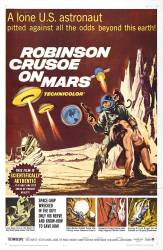Other mistake: The abandoned orbiter requires fuel to decelerate and drop out of its stable orbit. Mantee knew the orbiting spacecraft was out of fuel before leaving it, but he was still trying to give the craft voice commands to land some forty minutes into the film.

Robinson Crusoe On Mars (1964)
1 other mistake - chronological order
Directed by: Byron Haskin
Starring: Adam West, Paul Mantee, The Woolly Monkey, Victor Lundin
Genres: Sci-fi
Continuity mistake: Mantee finds a pool of water after falling through a hole. He gets in nude, but you can see him wearing tan-colored trunks during the close-ups. However, the far away shots do show him naked.
Trivia: The alien ships look almost like the Martian ships from the movie War of the Worlds minus the wires. However, they were neat to watch. Byron Haskin directed both Wars of the Worlds and Robinson Crusoe On Mars; thus, that is why they have the same spaceships.
Question: For someone stranded on Mars for several months, Mantee's hair and sideburns seem remarkably well-groomed, even, and trimmed! (He could have cut his hair with his knife, but wouldn't it have looked more shaggy and uneven than it does)?





Answer: In the movie before he discovers his water supply and watches the survival video, he is shown grooming himself and shaving.